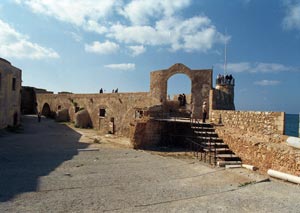92nd Anniversary of the Union of Crete with Greece celebrated at Chania
The 1st of December, the anniversary of the Union, is not widely celebrated today. Few people remember and fewer honour this anniversary of the achievement of an aspiration that expressed the spirit of Cretans for centuries and was their sole aim for decades. From the creation of the first tiny Greek state in a corner of the southern Balkans – a state which did not include Crete among its regions – the goal of all risings against the Turks was now “Union or death”, words inscribed on the banners of the revolutionaries. Events in Greece had a huge effect on what was happening in Crete.
 On this day, 92 years ago, the Greek Flag was raised for the first time over Firkas Fortress in the old harbour of Hania, ending a long period of darkness. Crete was unified with mother Greece and the population rejoiced at the vindication of their struggles.
On this day, 92 years ago, the Greek Flag was raised for the first time over Firkas Fortress in the old harbour of Hania, ending a long period of darkness. Crete was unified with mother Greece and the population rejoiced at the vindication of their struggles.
Hania’s solemn celebration of this historical anniversary was centred on Firkas Fortress in the old harbour. The symbol of the Nation, the Greek Flag, was borne there with in procession and raised just as it had been on the 1st of December 1913. A Greek navy frigate saluted the flag, while an F-16 fighter plane overflew the area.
Read the detailed history of the Union of Crete with Greece
Short History of Crete
In the partition of the Byzantine empire after the capture of Constantinople by the Latins in 1204, Crete was eventually acquired by Venice, which held it for more than four centuries. During the 17th century, Venice was pushed out of Crete by the Ottoman Empire, with most of the island lost after a siege lasting from 1648 to 1669 (the fall of Candia). This is possibly the longest siege in history. The last Venetian outposts on the island were lost in 1718, and Crete was a part of the Ottoman Empire for the next two centuries. There were significant rebellions against Ottoman rule, particularly in Sfakia. Daskalogiannis was a famous rebel leader.
The Greek War of Independence began in 1821 and Cretan participation was extensive. The Turks responded by seeking the aid of the Pasha of Egypt, and brutal campaigns crushed the island’s resistance. In 1832 a Greek state was established which, however, did not include Crete and the island passed to the Egyptians, in acknowledgement of their assistance. In 1840, Egypt returned Crete to the Ottoman Sultan.
After Greece achieved its independence, Crete became an object of contention as its Greek populations revolted twice against Ottoman rule (in 1866 and 1897). Ethnic tension prevailed on the island between the ruling Muslim minority and the Christian majority. Aided by volunteers and reinforcements from Greece, the “Great Cretan Revolt” began in 1866 and the rebels scored a series of victories. However, as more Turkish forces landed on the island, reprisals, usually against non-combatants, became common, and the revolt was crushed by 1869. The siege and subsequent explosion of the monastery of Arkadi in 1866 was a famous episode in this revolution.
A new Cretan insurrection in 1897 led to Turkey declaring war on Greece and defeating it. However, the Great Powers (Britain, France, Italy and Russia) decided that Turkey could no longer maintain control and intervened. Turkish forces were expelled in 1898, and an independent Cretan Republic, headed by Prince George of Greece, was founded. Taking advantage of domestic turmoil in Turkey in 1908, the Cretan deputies declared union with Greece. But this act was not internationally recognized until 1913 after the Balkan Wars. Under the Treaty of London, Sultan Mehmed V relinquished his formal rights to the island. In December, the Greek flag was raised at the Firkas fortress in Hania, with Venizelos and King Constantine in attendance, and Crete was unified with mainland Greece. The Muslim minority of Crete initially remained on the island but was later relocated to the Turkey, under the general population exchange agreed in the 1923 Treaty of Lausanne between Turkey and Greece.